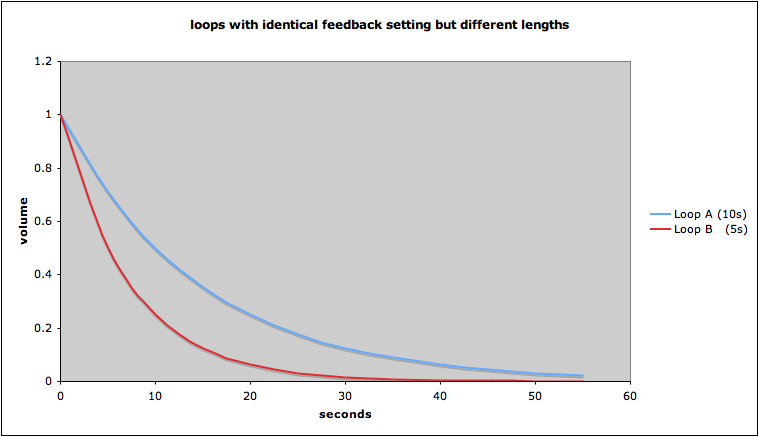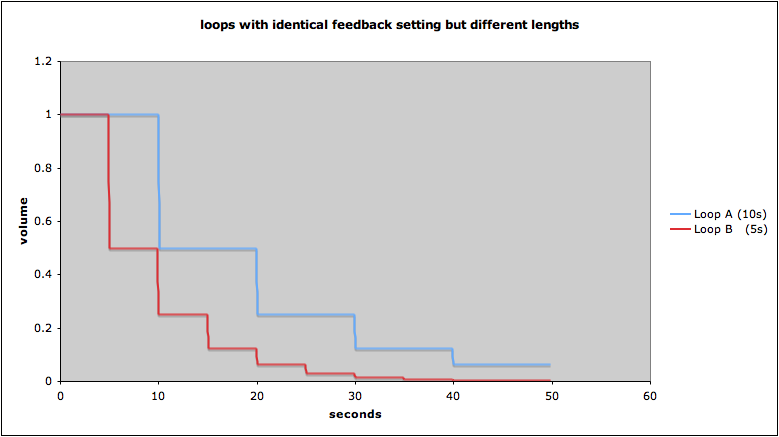Loop Feedback Control
Observation
The shorter a loop the more quickly it fades out.
Explanation
The feedback control sets the amount by which the volume is reduced per loop repetition. Thus, a shorter loop's volume will decrease by the same amount within less time than a longer loop.
Example
Feedback is set to 50%.
Loop A duration 10 s, feedback will decrease by 50% per repetition, i.e. every 10 seconds.
Loop B duration 5 s, feedback will decrease by 50% per repetition, i.e. every 5 seconds.
After 10 seconds Loop A will have diminished to 50%, Loop B will have diminished to 50% * 50% -> 25%

|
|
(assuming the feedback was moved exponentially down from 100% to 50% during the first run of the loop)
|

|
|
(assuming the feedback was moved briskly down from 100% to 50% during the first run of the loop. Thanks to Andy Butler for this graphic and for making the point.)
|
Parameters
| Parameter | Symbol | Unit | Range | Domain |
|---|
| feedback | F | % (percent) | 0-100 | integer |
| loop duration | LD | s (seconds) | [0,... | real |
| process duration | PD | s (seconds) | [0,... | real |
| repetitions (number of) | R | | [0,... | integer |
| volume | V | ? | ? | real |
| initial volume | V0 | ? | ? | real |
Formulas
| Formula | Description |
|---|
| (1) | V = V0 * (F/100)R | Resulting volume V at the end of repetition R for a loop with a feedback setting of F |
| (2) | R = PD / LD | Number of repetitions depending on process duration and loop duration |
Examples
What volume factor x will a 10-second-loop have decreased to after 60 seconds with a feedback setting of 80% ?
V0 * x = V0 * (F/100)(PD/LD); (using formula (1))
x = (F/100)(PD/LD) = 80/10060/10 = 0.86 = 0.26;
What feedback setting F will lead to a decrease in Volume by 90% within 30 seconds for a 10 second loop?
V = V0 * ( 100 - 90 ) / 100; (decrease by 90%)
V0 * 0.1 = V0 * (F/100)(PD/LD); (using formula (1))
F = 0.1(1/3) * 100 = 46 (59 in MIDI terms).
How many repetions R does it take until a loop's volume will have decreased to 10% with a feedback setting of 90% ?
V = V0 * 0.1;
V0 * 0.1 = V0 * (F/100)R; (using formula (1))
0.1 = (9/10)R;
log (0.1) = R * log (0.9);
R = log(0.1) / log (0.9) = 22;
Remarks
- Changes of the feedback setting will only be audible in the next repetition of the loop.
- Gestures with the feedback control will be recorded with the loop and become part of it.
- We're using 100 as the maximum for the feedback setting. When using the EDP, maximum setting is 127 (due to MIDI). Thus, the formula (1) above would read: V = V0 * (F/127)R
- Volume in the text refers to Amplitude (not Loudness).
Thanks
© Bernhard Wagner, 2006.


